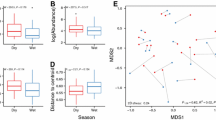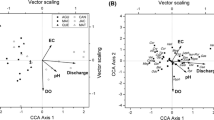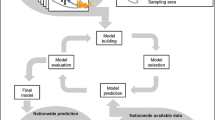Abstract
Variability in biodiversity is often assessed based on species richness, and this adherence to a single index has been typical in studies of ecology, biogeography, and conservation in the past two decades. More recent studies have suggested that species richness alone is insufficient as a measure of biodiversity, mainly because it is not necessarily correlated with other measures of biodiversity. We examined (1) if nine indices embracing species diversity, functional diversity, and taxonomic distinctness of stream macroinvertebrate assemblages show congruent patterns, and (2) if these indices show similar relationships to landscape characteristics. Not all indices varied similarly and were thus not significantly correlated. There were three principal components that effectively described variation in the correlation structure of the nine indices. These three components were: (1) diversity and evenness indices, (2) two indices of taxonomic distinctness, and (3) species richness and functional richness. Four of the nine biodiversity indices examined showed no significant relationships to landscape-catchment characteristics, and even the significant correlations between the remaining five indices and explanatory variables were rather weak. However, species richness showed a rather strong quadratic relationship to catchment area. Our study provided a number of suggestions for future biodiversity studies at the landscape scale. First, given that different indices describe different components of biodiversity and are not strongly correlated, multiple indices should be considered in any study describing stream biodiversity. Second, despite the study was restricted to near-pristine streams, all indices showed considerable variation. Thus, this natural variability should be accounted for prior to the examination of anthropogenic effects on stream biodiversity. Third, landscape-catchment variables may have only limited value in explaining variability in biodiversity indices, at least in regions with no strong anthropogenic gradients in land-use.

Similar content being viewed by others
References
Allen TFH, Starr TB (1982) Hierarchy: perspectives for ecological complexity. University of Chicago Press, Chicago
Brown JH (1995) Macroecology. University of Chicago Press, Chicago
Clarke KR, Warwick RM (1998) A taxonomic distinctness index and its statistical properties. J Appl Ecol 35:523–531
Covich AP, Palmer MA, Crowl TA (1999) The role of benthic invertebrate species in freshwater ecosystems. Bioscience 49:119–127
Faith DP, Walker PA (1996) Environmental diversity: on the best possible use of surrogate data for assessing the relative biodiversity of sets of areas. Biodivers Conserv 5:399–415
Ferrier S, Guisan A (2006) Spatial modelling of biodiversity at the community level. J Appl Ecol 43:393–404
Finn DS, Poff NL (2005) Variability and convergence in benthic communities along the longitudinal gradients of four physically similar Rocky Mountain streams. Freshw Biol 50:243–261
Fore LS, Karr JR, Wisseman RW (1996) Assessing invertebrate responses to human activities: evaluating alternative approaches. J North Am Benthol Soc 15:212–231
Forman RTT (1995) Land mosaics: the ecology of landscapes and regions. Cambridge University Press, Cambridge
Frissell CA, Wiss WJ, Warren CE, Huxley MD (1986) A hierarchical framework for stream classification: viewing streams in watershed context. Environ Manage 10:199–214
Gaston KJ (1996) Species richness: measure and measurement. In: Gaston KJ (ed) Biodiversity. A biology of numbers and difference. Blackwell Science, Oxford, pp 77–113
Giller PS, Malmqvist B (1998) The biology of streams and rivers. Oxford University Press, Oxford
Hall SJ, Greenstreet SPR (1998) Taxonomic distinctness and diversity measures: responses in marine fish communities. Mar Ecol Prog Ser 166:227–229
Hammer Ø, Harper DAT (2005) PAST version 1.34. http://folk.uio.no/ohammer/past/
Hawkins CP, Norris RH, Gerritsen J, Hughes RM, Jackson SK, Johnson RK, Stevenson RJ (2000) Evaluation of the use of landscape classifications for the prediction of freshwater biota: synthesis and recommendations. J North Am Benthol Soc 19:541–556
Heino J (2005a) Functional biodiversity of macroinvertebrate assemblages along major ecological gradients of boreal headwater streams. Freshw Biol 50:1578–1587
Heino J (2005b) Metacommunity patterns of highly diverse stream midges: gradients, checkerboards and nestedness, or is there only randomness? Ecol Entomol 30:590–599
Heino J (2008) Influence of taxonomic resolution and data transformation on biotic matrix concordance and assemblage-environment relationships in stream macroinvertebrates. Boreal Environ Res (in press)
Heino J, Muotka T, Paavola R, Hämäläinen H, Koskenniemi E (2002) Correspondence between regional delineations and spatial patterns in macroinvertebrate assemblages of boreal headwater streams. J North Am Benthol Soc 21:397–413
Heino J, Muotka T, Mykrä H, Paavola R, Hämäläinen H, Koskenniemi E (2003a) Defining macroinvertebrate assemblage types of headwater streams: implications for bioassessment and conservation. Ecol Appl 13:842–852
Heino J, Muotka T, Paavola R, Paasivirta L (2003b) Among-taxon congruence in biodiversity patterns: can stream insect diversity be predicted using single taxonomic groups? Can J Fish Aquat Sci 60:1039–1049
Heino J, Soininen J, Lappalainen J, Virtanen R (2005a) The relationship between species richness and taxonomic distinctness in freshwater organisms. Limnol Oceanogr 50:978–986
Heino J, Paavola R, Virtanen R, Muotka T (2005b) Searching for biodiversity indicators in running waters: do bryophytes, macroinvertebrates, and fish show congruent diversity patterns? Biodivers Conserv 14:415–428
Heino J, Mykrä H, Hämäläinen H, Aroviita J, Muotka T (2007) Responses of taxonomic distinctness and species diversity indices to anthropogenic impacts and natural environmental gradients in stream macroinvertebrates. Freshw Biol 52:1846–1861
Johnson L, Gage SH (1997) Landscape approaches to the analysis of aquatic ecosystems. Freshw Biol 37:113–132
Johnson L, Richards C, Host GE, Arthur JW (1997) Landscape influences on water chemistry in Midwestern stream ecosystems. Freshw Biol 37:193–208
Lamouroux N, Dolédec S, Gayraud S (2004) Biological traits of stream macroinvertebrate communities: effects of microhabitat, reach and basin filters. J North Am Benthol Soc 23:449–466
Magurran AE (2004) Measuring biological diversity. Blackwell Science, Oxford
Malmqvist B, Eriksson Å (1995) Benthic insects in Swedish lake outlet streams: patterns in species richness and assemblage structure. Freshw Biol 34:285–296
Malmqvist B, Hoffsten P-O (2000) Macroinvertebrate taxonomic richness, community structure and nestedness in Swedish streams. Arch Hydrobiol 150:29–54
Malmqvist B, Mäki M (1994) Benthic macroinvertebrate assemblages in north Swedish streams: environmental relationships. Ecography 17:9–16
McCune B, Mefford MJ (1999) PC-Ord. Multivariate analysis of ecological data. Version 4.25. MjM Software, Gleneden Beach
Merritt RW, Cummins KW (1996) An introduction to the aquatic insects of North America. Kendall/Hunt Publishing, Dubuque
Minshall GW (1985) Species richness in stream of different size from the same drainage basin. Am Nat 125:16–38
Moog O (ed) (2002) Fauna Aquatica Austriaca. Katalog zur autoökologischen Einstufung aquatischer Organismen Österreichs. Bundesministerium für Land- und Forstwirtschaft. Umwelt und Wasserwirtschaft, Wien
Muotka T, Virtanen R (1995) The stream as a habitat template for bryophytes: species’ distributions along gradients in disturbance and substratum heterogeneity. Freshw Biol 33:141–160
Mykrä H, Ruokonen T, Muotka T (2006) The effect of sample duration on the efficiency of kick-sampling in two streams with contrasting substratum heterogeneity. Verh Int Ver Theor Angew Limnol 29:1351–1355
Ormerod SJ, Edwards RW (1987) The ordination and classification of macroinvertebrate assemblages in the catchment of the river Wye in relation to environmental factors. Freshw Biol 17:533–546
Petchey OL, Evans KL, Fishburn IS, Gaston KJ (2007) Low functional diversity and no redundancy in British avian assemblages. J Anim Ecol 76:977–985
Pielou EC (1975) Ecological diversity. Wiley, New York
Poff NL (1997) Landscape filters and species traits: towards mechanistic understanding and prediction in stream ecology. J North Am Benthol Soc 16:391–409
Ricklefs RE, Schluter D (1993) Species diversity in ecological communities. University of Chicago Press, Chicago
Rogers SI, Clarke KR, Reynolds JD (1999) The taxonomic distinctness of coastal bottom-dwelling fish communities of the North-east Atlantic. J Anim Ecol 68:769–782
Rosenzweig ML (1995) Species diversity in space and time. Cambridge University Press, Cambridge
Sanderson RA, Eyre MD, Rushton SP (2005) The influence of stream invertebrate composition at neighbouring sites on local assemblage composition. Freshw Biol 50:221–231
Sandin L, Johnson RK (2000) Ecoregions and benthic macroinvertebrate assemblages of Swedish streams. J North Am Benthol Soc 19:462–474
Schmedtje U, Colling M (1996) Ökologische Typisierung der aquatischen Makrofauna. Bayerisches Landesamt für Wasserwirtschaft, München
SPSS Inc. (2002) SPSS version 11.5 for Windows. SPSS Inc., Chicago
Stevens RD, Cox SB, Strauss RE, Willig MR (2003) Patterns of functional diversity across an extensive environmental gradient: vertebrate consumers, hidden treatments and latitudinal trends. Ecol Lett 6:1099–1108
Stirling G, Wilsey B (2001) Empirical relationships between species richness, evenness, and proportional diversity. Am Nat 158:286–299
Tonn WM (1990) Climate change and fish communities: a conceptual framework. Trans Am Fish Soc 119:337–352
Townsend CR, Hildrew AG, Francis J (1983) Community structure in some southern English streams: the influence of physicochemical factors. Freshw Biol 13:521–544
Usseglio-Polatera P, Bornaud M, Richoux P, Tachet H (2000) Biological and ecological traits of benthic freshwater macroinvertebrates: relationships and definition of groups with similar traits. Freshw Biol 43:175–205
Vannote RL, Minshall GW, Cummins KW, Sedell JR, Cushing CE (1980) The river continuum concept. Can J Fish Aquat Sci 37:130–137
Van Sickle J, Hughes RM (2000) Classification strengths of ecoregions, catchments, and geographic clusters for aquatic vertebrates in Oregon. J North Am Benthol Soc 19:370–384
Vinson MJ, Hawkins CP (1998) Biodiversity of stream insects: variation at local, basin and regional scales. Annu Rev Entomol 43:271–293
von Euler F, Svensson S (2001) Taxonomic distinctness and species richness as measures of functional structure in bird assemblages. Oecologia 129:304–311
Vuori K-M, Muotka T (1999) Benthic communities in humic streams. In: Keskitalo J, Eloranta P (eds) Limnology of humic waters. Backhuys, Leiden, pp 193–207
Wallace JB, Webster JR (1996) The role of macroinvertebrates in stream ecosystem function. Annu Rev Entomol 41:115–139
Warwick RM, Clarke KR (1995) New “biodiversity” indices reveal a decrease in taxonomic distinctness with increasing stress. Mar Ecol Prog Ser 129:301–305
Warwick RM, Clarke KR (1998) Taxonomic distinctness and environmental assessment. J Appl Ecol 35:532–543
Willig MR, Kaufman DM, Stevens RD (2003) Latitudinal gradients of biodiversity: pattern, process, scale and synthesis. Annu Rev Ecol Syst 34:273–309
Wilsey BJ, Chalcraft DR, Bowles CM, Willig MR (2005) Relationships between indices suggest that richness is an incomplete surrogate for grassland biodiversity. Ecology 86:1178–1184
Acknowledgements
This study was financially supported by the Academy of Finland (grants to J. Heino and T. Muotka). We thank Oulanka Research Station for logistical support during the study.
Author information
Authors and Affiliations
Corresponding author
Rights and permissions
About this article
Cite this article
Heino, J., Mykrä, H. & Kotanen, J. Weak relationships between landscape characteristics and multiple facets of stream macroinvertebrate biodiversity in a boreal drainage basin. Landscape Ecol 23, 417–426 (2008). https://doi.org/10.1007/s10980-008-9199-6
Received:
Accepted:
Published:
Issue Date:
DOI: https://doi.org/10.1007/s10980-008-9199-6




